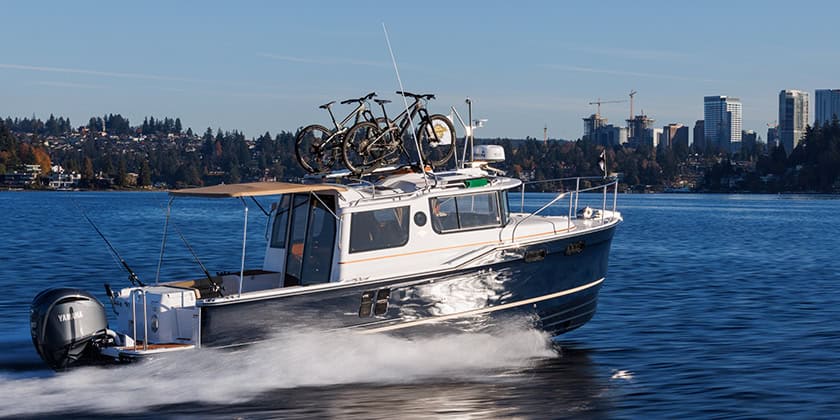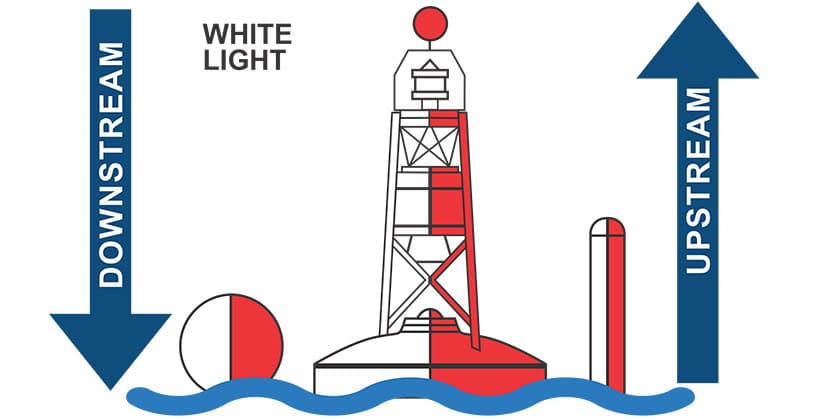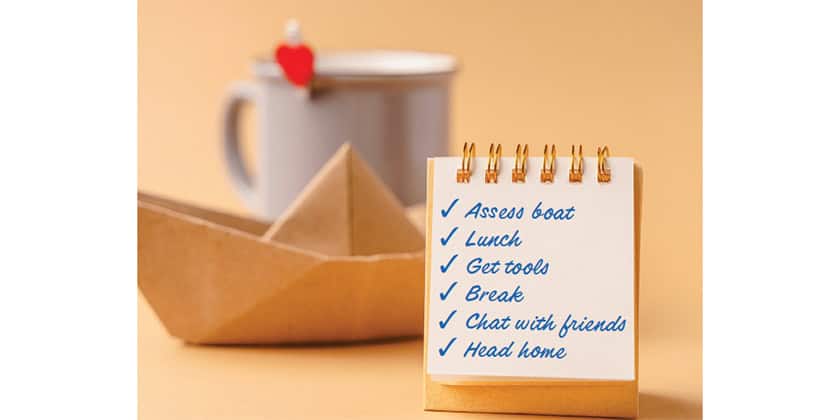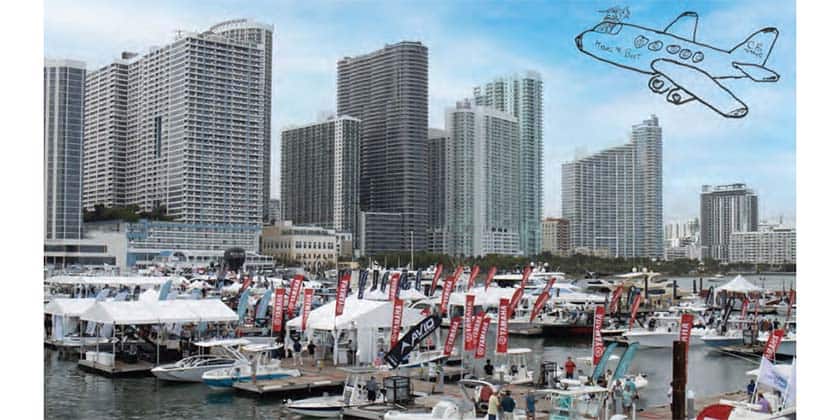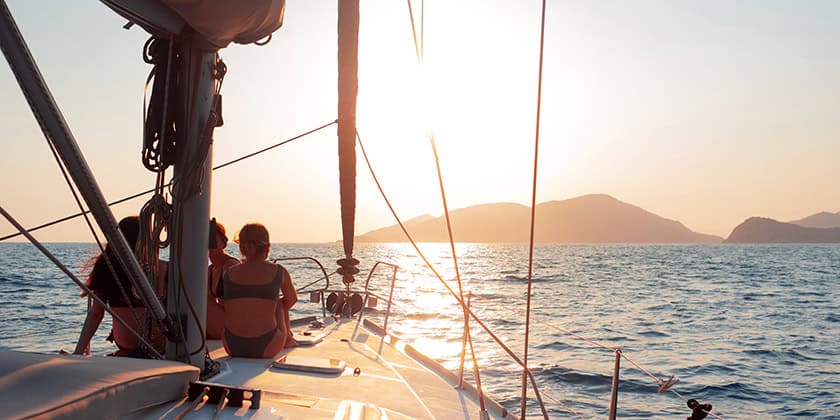Bayfield 29
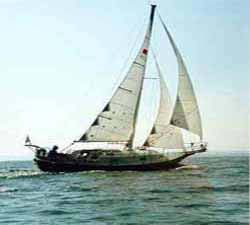 By Carol Nickle & Bryan Gooderham
By Carol Nickle & Bryan Gooderham
The 29 is as traditional in appearance as a fibreglass production yacht can be. Its springy sheer line concludes forward in a bowsprit/platform; the silhouette is high; the underwater shape features a deep forefoot and a long, full keel with rudder attached; and the modest sail area is distributed in a cutter rig, with no provision for a spinnaker. The bow sections are fairly full, and the beam compares with those of some larger performance-oriented yachts. The design of the Bayfield 29 specifies a displacement of 7,100 pounds. Bayfield’s president, Jake Rogerson, notes that the boat is actually built heavier and stronger than called for, which places its actual displacement around 8,500 pounds.
We sailed the Bayfield 29 on an overcast fall day with eight to 10 knots of wind and a modest Lake Ontario chop. The boat provided a very stable, dry ride, though we encountered a considerable amount of weather helm, which Rogerson says can be compensated by trimming the mainsail with the boom to leeward.
An unusual feature of the Bayfield 29 is its cutter rig, with a staysail and topsail rather than the more common single headsail. For larger boats, particularly in the years before roller furling and electric winches, the cutter rig has provided a practical way to reduce sail in manageable proportions, especially when sailing shorthanded. The main disadvantages of the rig lie in the extra tackle and rigging it entails and complications in tacking. Although there is almost no sail overlap with the mast, thereby avoiding the rig interference in tacking associated with larger genoas; we found tacking a cutter rig still requires patience. The topsail must squeeze through the narrow space between the forestay and the staysail, without a tacking line to help the foot of the jib along. We also found that, on the 29, the staysail cleat fouled the topsail sheet during tacks.
Jake Rogerson counters that tacking a cutter rig well is simply a matter of adopting a systematic approach. The smaller staysail should be tacked first, he says; the topsail goes last, after the mainsail. Because the topsail is backed at this point, “it goes through like a firecracker,” says Rogerson. He also believes that, without the long foot of the genoa to grind in, the cutter rig is quicker to trim and thus quicker to accelerate once on the new tack.
We noticed on the Bayfield 29 on display at the Toronto International Boat Show that the tang and the jaw of the bobstay were not compatible sizes. While Rogerson asserts that he has never come across bobstay failure on the Bayfield 29, the installation gave us concern, as the bobstay, which runs from the bow of the boat near the waterline to the bow platform, assumes the load of the forestay.
Clive Taylor has owned a 29 for one season. He is pleased with the boat’s performance; the only problems he reports were leaky chainplates and mild weather helm, both of which he says have been corrected. The 29 is not a party boat, he notes, as its long cabin trunk, which provides plenty of interior volume, makes for a short cockpit. With the Edson wheel steering (a $1,000 option) the helmsman can sit on a raised seat for good visibility. When he is standing, however, the wheel squeezes him against the edge of the seat, and there is no room on the rail for a comfortable perch.
Bayfield elected to attach the mainsheet to the end of the broom and run it to a rather short traveller track across the aft cockpit coaming. Though this approach is used on other boats and may get the mainsheet out of the crew’s hair, we feel the resultant sheeting angle makes attaining proper leech tension difficult. In the case of the 29, the sheet also brushes against the skipper who opts for wheel steering. Choosing tiller steering gets the helmsman away from the mainsheet, but the long tiller places legroom for passengers and crew at a premium. The mainsheet problem might be solved, albeit at the sacrifice of cockpit space, by locating the traveller just forward of the binnacle with wheel steering, or immediately aft of the companionway in models with tillers. Understandably, when interior volume takes precedence over cockpit volume, design compromises will arise that have no magic cure.
Cubbyholes in the cockpit sides and under the helmsman’s seat provide storage space. Stanchions are sturdy and well secured. Their position a few inches inboard, to accommodate solid backing plates, slightly reduces the potential working area of the deck. Lines, fenders and other assorted gear are standard equipment, as are the sails, a Hong Kong brand. Bayfield is generous with its standard winch package, providing seven Lewmar winches four in the cockpit for tending the two headsails and a surprising three more for the halyard. Another builder might have limited the halyard winches to one, or even two, and compensated for the others with linestoppers.
The anodized aluminum mast is stepped on a large block of plywood fiber-glassed in place as a semi-structural floor right on the keel. The keel shape is formed in the mold with the rest of the hull, and the ballast is then lowered in.
The shallow draft of the long keel is one of the most appealing features of the Bayfield 29. What it surrenders to fin keels in performance it counters with a saving in draft of up to two feet over its racier cousins. Although you would never put them to the same purpose, it’s interesting to note that the 29 draws three inches less than a J/22, which is welcome news to cruisers determined to slip into thin-water anchorages without settling for the living accommodations of a smaller design. The deep bilge, always a welcome feature, has the added advantage of providing excellent storage space for canned goods and extra chain.
The 29 makes a striking departure from conventional interior designs through its lack of V berth. Sleeping space is provided instead by two quarter-berths, a single settee berth to port and a double pullout settee berth to starboard. The double berth assembles with pleasing simplicity. The spacious interior boasts a rather nice headliner with overhead grabrails and a carpeted saloon floor; more lights would be an asset. The interior teak is unfinished, as in all Bayfield models. Bayfield does not finish the teak, says Rogerson, because of the considerable amount of wood the company installs in a boat and the fact that some owners prefer varnish over oil. Rogerson recommends finishing the teak to ensure its longevity.
Upholstery is neat and unassuming. Shelves are found behind both settees, and inside each settee is a stowage locker. The fiberglass finish in these lockers is quite good, though the inside of the locker lids is rough and should not be trusted around clothing without protection. The mast descends through the forward end of the ample, fixed, folding table, which has a bottle rack.
Where one would normally find a V berth there is instead an unusually large head compartment and, farther forward, a large hanging locker. An exceptional amount of storage can be found in lockers outboard of the head and the vanity and under the central seat. On the floor is a molded sump with teak grate for showering. Despite the size of the compartment, the 29 somehow ended up being the only model in the head–an oversight Bayfield is happy to correct.
Amidships are two bulkhead walls whose sliding teak dividers allow more privacy for the main saloon. Aft of the bulkheads, the Bayfield 29’s standard configuration places the main galley area to starboard and the icebox and nav station to port, with a quarterberth immediately aft on each side. A drop panel provides counter space over the head of the starboard berth; to port the nav table has a similar hinged panel, which lengthens the berth. Even with the hinged panel, we found the port quarterberth short for a reasonably tall adult, though a child would have ample room.
Clive Taylor modified his 29 by foregoing the starboard berth using all the available space on the starboard quarter for a more spacious galley. For the singlehander or couple who plan extended cruises, this alternative makes living aboard more practical and comfortable.
In the standard layout the L-shaped galley features a first-rate, two-burner, Origo alcohol stove with cutting board. Recessed about four inches from the counter face, it does not gimbal. The stainless steel sink is a touch shallow and is equipped with an institutional looking brass faucet. A typical marine-type fixture with greater height would be more suitable and would make it easier to fill a bottle or a kettle. Bayfield has moved to correct the problem by giving the faucet a different mount.
The dry locker behind the stove has one partial shelf. Additional stowage is provided by lockers outboard of the galley to starboard and of the icebox to port. There is also a cupboard with shelves under the counter inboard of the icebox, in which the icebox drain is located.
The icebox has a single rack in the bottom. On Clive Taylor’s boat we encountered the all-too-frequent production-boat problem of lack of insulation on the underside of the countertop. Rogerson reports that the latest 29s in production benefit from two-part foam insulation. Aft of the icebox is the nav table. Located away from the nav station, on the opposite side of the companionway, is the hinged electrical panel with 15©amp breakers.
Engine access is the best we have seen on a boat of this size. It is, in a word terrific. Rogerson relates that a Bayfield 29 on the east coast requiring servicing had its engine sitting on the deck within half an hour, and it’s not hard to see how. In summary, we found the Bayfield 29 to be a comfortable, sturdy design with oceangoing capability, appealing most to the cruising couple or the single-handed sailor.
Originally published in Canadian Yachting’s May 1985 issue.
Read the Bayfield 32 Review
Read the Bayfield 36 Review
View all Sail Reviews
View all Boat Reviews
Can’t find the boat you are looking for? Email us your boat review request: Terri Hodgson thodgson@kerrwil.com










